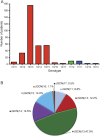Correlation between PABPN1 genotype and disease severity in oculopharyngeal muscular dystrophy
- PMID: 28011929
- PMCID: PMC5272966
- DOI: 10.1212/WNL.0000000000003554
Correlation between PABPN1 genotype and disease severity in oculopharyngeal muscular dystrophy
Abstract
Objective: Oculopharyngeal muscular dystrophy (OPMD) is an autosomal dominant adult-onset disease characterized by progressive ptosis, dysphagia, and proximal limb weakness. The genetic cause is an expanded (GCN)n mutation in the PABPN1 gene encoding for the polyadenylate-binding protein nuclear 1. We hypothesized a potential correlation between the size of the (GCN)n expansion and the severity of the phenotype. To do this, we characterized the distribution of the genotypes as well as their correlation with age at diagnosis and phenotypical features in a large cohort of heterozygous and homozygous patients with OPMD in France with a confirmed molecular diagnosis of PABPN1.
Methods: We explored 354 unrelated index cases recruited between 1999 and 2014 in several neuromuscular centers in France.
Results: This cohort allowed us to characterize the frequency of mutated alleles in the French population and to demonstrate a statistical correlation between the size of the expansion and the mean age at diagnosis. We also confirmed that homozygous patients present with a more severe disease.
Conclusions: It has been difficult to establish phenotype-genotype correlations because of the rare nature of this disease. Our work demonstrates that patients with OPMD with longer PABPN1 expansion are on average diagnosed at an earlier age than patients with a shorter expansion, confirming that polyalanine expansion size plays a role in OPMD, with an effect on disease severity and progression.
Copyright © 2016 The Author(s). Published by Wolters Kluwer Health, Inc. on behalf of the American Academy of Neurology.
Figures


References
-
- Bouchard JP, Brais B, Brunet D, Gould PV, Rouleau GA. Recent studies on oculopharyngeal muscular dystrophy in Quebec. Neuromuscul Disord 1997;7(1 suppl):S22–S29. - PubMed
-
- Brais B, Bouchard JP, Xie YG, et al. . Short GCG expansions in the PABP2 gene cause oculopharyngeal muscular dystrophy. Nat Genet 1998;18:164–167. - PubMed
-
- Tondo M, Gamez J, Gutierrez-Rivas E, Medel-Jimenez R, Martorell L. Genotype and phenotype study of 34 Spanish patients diagnosed with oculopharyngeal muscular dystrophy. J Neurol 2012;259:1546–1552. - PubMed
-
- Shan J, Chen B, Lin P, et al. . Oculopharyngeal muscular dystrophy: phenotypic and genotypic studies in a Chinese population. Neuromolecular Med 2014;16:782–786. - PubMed
Publication types
MeSH terms
Substances
LinkOut - more resources
Full Text Sources
Other Literature Sources
Medical
